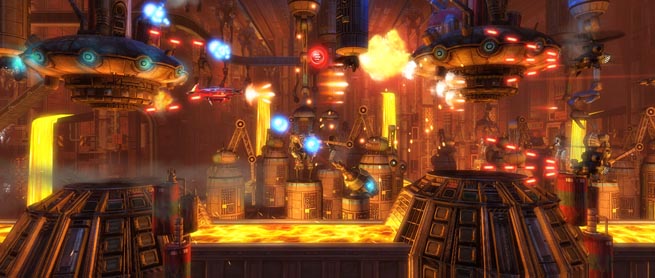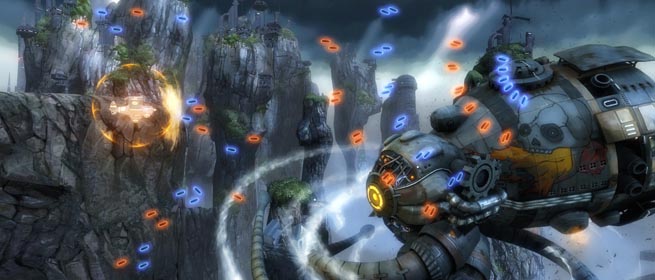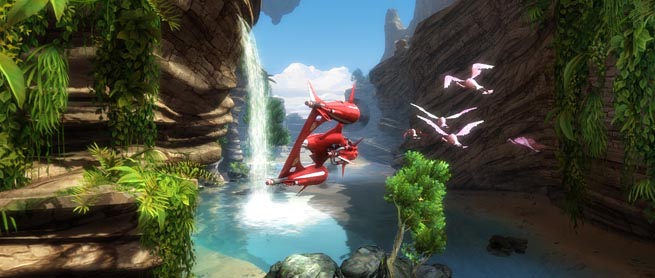Sine Mora inspires a certain amount of wondering about what a 2D shooter really needs in the way of production values. Does it need an original soundtrack by a big-name composer? Does it need an extensive, otherworldly backstory? Does it need an elaborate time-travel plotline about saving someone’s life in the past and avenging his death in the present? Does it need poetically-written cutscenes and voice-overs delivered in Hungarian?
In this case, at least, the answer is, “maybe not, but it’s cool that they took the time.” It’s especially cool because the fancy production isn’t hiding a subpar game. Sine Mora is a fine little side-scrolling shooter with a slick mix of old-school and new-school design. The subtitled-foreign-movie style laid on top of it shouldn’t scare away anybody who just feels like shooting stuff.
A lot of folks will see the Grasshopper Manufacture bumper in front of Sine Mora and assume that Goichi Suda is up to his old madness. In fact, though, the creator of No More Heroes and Killer 7 had only so much to do with most of the weird stuff going on here. Grasshopper stuck to providing the sound design (including somber, low-key music by Silent Hill’s Akira Yamaoka) and some concept art for this project. Instead, thank a fellow named Theodore Reiker, who wrote, designed, and directed the whole shebang at the helm of a Budapest-based shop, Digital Reality.
WHAT YOU’LL LIKE
Varied design
Reiker, you get the feeling, has had a story percolating in his brain for a very long time. You also get the feeling that the man loves 2D shooters as much as life itself. Sine Mora is fun to play for gamers with any level of shooter experience (and more on that balancing act a little later), but real shooter geeks will get something more out of the experience. They’ll notice this bit from that game or that bit from this game, a sub-weapon from Radiant Silvergun, a level design gimmick from Life Force. Playing spot-the-reference is a fun diversion all by itself.
Despite all that, the whole package doesn’t owe too much to any one game or style of shooter. For some stretches, partcularly the earlier sections of seven lengthy stages, it’s a slow-paced game out of the 16-bit era, often with an emphasis on careful maneuvering through tight physical spaces. Think of something along the lines of the Gradius or Thunder Force series. When the bosses show up, which is often enough to bring to mind a Treasure game like Alien Soldier, the tempo picks up and it turns into more of a Cave-style shooter, one of those bullet hell games where clouds of shots stream across the screen in giant fractals of death.
One thing Sine Mora doesn’t do, as a rule, is repeat itself. None of the levels or bosses are quite alike, and some of them dish up a genuine surprise. Stage three has what amounts to a stealth-action passage, matching speeds and position with some camouflaging junk to sneak through a tunnel full of laser tripwires. Stage six finishes off with a devilish rat maze of a battle, where the goal is to weave through the passages of a circular labyrinth as it constantly rotates and changes the position of each tunnel.
Time-based gameplay
Meanwhile, the core of the game is an idea that Digital Reality came up with on its own. In Sine Mora, time is life and life is time. There’s a clock counting down at the top of the screen – that represents how long the player has to live. Running into enemy shots doesn’t add up to instant death, but it does knock a few seconds off the clock. To fill the timer back up, just blow away enemies and snag the power-ups they leave behind.
Time also figures in to a handy defensive feature. The heroes of the game, for reasons that you can read about in Sine Mora’s unlockable backstory encyclopedia (really), are able to briefly control the passage of time. In short, they have bullet time, just like Max Payne, plus a couple of variations on the theme that reveal themselves as unlockable extras. It’s a nifty wrinkle in the familiar process of ducking and weaving through those crazy clouds of bullets.
The entire game is surprisingly replayable after some time to unlock hidden characters and weapon combinations. Early trips through the story mode have pre-set selections in that department – use this ship and this weapon for this level. Soon enough, though, it becomes possible to pick and choose from several weapon combinations and come up with a signature style.
Modern 3D graphics
For players who’ll never see the top end of the high score lists, all the sightseeing in Sine Mora makes for an entertaining trip. There are towering bosses, multi-layered backgrounds, and lots of cool camera movement to show off the best of the animation and modeling.
The creators call the overarching design sense “diesel-punk.” It’s an interesting change of pace from the usual sci-fi shooter visuals – like a certain style of Japanese animation, the kind that features aircraft ripped from Howard Hughes’s nightmares when he was deep into the drugs-and-pizza years. You’ll know the look if you’ve seen TV shows like Last Exile or movies like Sky Crawlers. The skies are full of huge, ornate flying machines that would never leave the ground anywhere but a cartoon or a video game, and more’s the pity.
Shooter connoisseurs might remember an old Cave production, Storm of Progia, which did something visually similar on the Capcom CPS2 arcade board, but that was a straightforward sprite-based game. Progia didn’t have the swooping camera or background detail that Sine Mora’s 3D presentation makes possible.
WHAT YOU WON’T LIKE
The easy parts are very easy
Sine Mora’s difficulty tuning is gentle on players who just want to enjoy the sights and follow the story. It’s actually pretty hard to die for good and all on the basic level – the game’s very generous with time-extension pickups, especially in what would otherwise be a rough final boss battle.
This is something that some of you won’t like, so to speak. The hardest of the shooter diehards may scoff at a game that allows the player to survive so many hits and keep on plugging. Which is fine – they can go back to cheerfully beating themselves about the head with R-Type Delta or Pulstar. For most of us, though, Sine Mora’s timing system combines with the different kinds of challenge in each level to give it a smooth ebb and flow. It also made it easy for Digital Reality to mix up how hard it is to survive and see the end of the game.
Those diehards can at least rest assured that unlocking all the achievements in Sine Mora is a feat demanding thumbs of steel. Besides the manual difficulty setting in the options, the game changes up its challenge level automatically. Take a beating and the bad guys will die a little quicker, do well for a long stretch and they’ll get a lot meaner. Staying at the highest A level all the way is the key to racking up a leaderboard-worthy score.
CONCLUSION
It would have been easier for Grasshopper and Digital Reality to make Sine Mora strictly for those shooter fiends. That’s how games like this are generally built in Japan, by and for a tiny cult of people with superhuman reflexes. They’re still very impressive as works of art and craftsmanship, often with production values up on this same level, but playing them tends to become an uncomfortably masochistic experience. They don’t have Sine Mora’s variety of challenges, and they tend to stick the needle at the far end of the toughness gauge.
Mr. Reiker and his crew didn’t have to build and tune their game so ordinary players could give it a shot. But they did, and good on ‘em for going to the trouble.
Score: 85/100
Sine Mora was released on March 21, 2012 for the Xbox 360. A downloadable code was provided by the publisher for the purpose of this review.
VentureBeat's mission is to be a digital town square for technical decision-makers to gain knowledge about transformative enterprise technology and transact. Learn More



